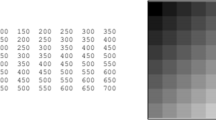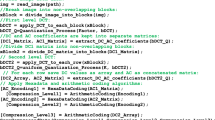Abstract
The most extensive data storage size is significantly increasing, and storing such data, including images to make them obtainable over the network, has become a significant problem. Thus, efficient compression techniques are necessary because the original images need much disk space. Generally, the primary purpose of image compression is to decrease the amount of data required for representing digital images. Image compression techniques can be categorized into lossless and lossy. Rounding Intensity followed by the Dividing Technique (FIRD) is a known lossy technique utilized in the proposed method that aims to reduce the range of the intensities and increase redundancy, achieving better compression performance. The main idea of this paper is to separate the (8*8 block of mage) into two parts: the matrix of hundreds and the single matrix. The elements in the hundreds matrix will be divided into 10, and the resulted matrix will be compressed using the Huffman technique. The elements in the single matrix will be rounded as follow: 0,1,2,3, and 4 to 2, and the elements 5, 6, 7, 8, and 9 are rounded to 7. Then, the Huffman technique will be applied to the resulting matrix. The previously generated values are combined, and the initial results indicate a reduction in distortion with better compression performance. This paper deals with whether the proposed technique enhancing the quality of Compressed Images using Rounding Intensity Followed by the Dividing Technique (E-RFID) can be used as a distinctive option in the distortion reduction process image a high compression ratio. In addition, image compression technology and quality enhancement with high compression explain each step's work, which will be presented in detail. The research factors have been positively impacted by improving the results and comparing them through MSE, PSNR, and MAE. The E-RIFD technique experiments showed an improved rate in MSE 66.82% and PSNR 18.31%, while the MAE improvement rate was 21.09% for grayscale images. However, when testing color images, the results show that the rate of improvement in MSE was 66.59% and PSNR 15.28, while the improvement rate in the MAE was 18.64%.


























Similar content being viewed by others
Data Availability
Data is available from the authors upon reasonable request.
References
Abualigah L, Al-Okbi NK, Elaziz MA, Houssein EH (2022) Boosting marine predators algorithm by salp swarm algorithm for multilevel thresholding image segmentation. Multimed Tools Appl 81(12):16707–16742
Abualigah L et al (2021) A novel evolutionary arithmetic optimization algorithm for multilevel thresholding segmentation of covid-19 ct images. Processes 9(7):1155
Alshami AL, Otair M (2018) Enhancing quality of lossy compressed images using minimum decreasing technique. Int J Adv Comput Sci Appl 9(3):397–404
Cao Q et al (2020) A brightness-preserving two-dimensional histogram equalization method based on two-level segmentation. Multimed Tools Appl 79(37):27091–27114
Chung K-L, Hsu C-H (2006) Novel prediction-and subblock-based algorithm for fractal image compression. Chaos Solitons Fractals 29(1):215–222
Chung K-L, Liu Y-W, Yan W-M (2006) A hybrid gray image representation using spatial-and DCT-based approach with application to moment computation. J Vis Commun Image Represent 17(6):1209–1226
Cristóbal G, Schelkens P, Thienpont H (eds) (2013) Optical and digital image processing: fundamentals and applications. John Wiley & Sons, Hoboken
Dorafshan S, Thomas RJ, Maguire M (2018) Comparison of deep convolutional neural networks and edge detectors for image-based crack detection in concrete. Constr Build Mater 186:1031–1045
Ewees AA et al (2021) Modified Artificial Ecosystem-Based Optimization for Multilevel Thresholding Image Segmentation. Mathematics 9(19):2363
Ezugwu AE et al (2022) A comprehensive survey of clustering algorithms: State-of-the-art machine learning applications, taxonomy, challenges, and future research prospects. Eng Appl Artif Intell 110:104743
Gandomi AH, Chen F, Abualigah L (2022) Machine learning technologies for big data analytics. Electronics 11(3):421
Gharaibeh M et al (2021) Early Diagnosis of Alzheimer’s Disease Using Cerebral Catheter Angiogram Neuroimaging: A Novel Model Based on Deep Learning Approaches. Big Data Cogn Comput 6(1):2
Gharaibeh M et al (2022) Radiology Imaging Scans for Early Diagnosis of Kidney Tumors: A Review of Data Analytics-Based Machine Learning and Deep Learning Approaches. Big Data Cogn Comput 6(1):29
Hore A, Ziou D (2010) Image quality metrics: PSNR vs. SSIM. in 2010 20th international conference on pattern recognition. IEEE
Houssein EH et al (2021) An improved opposition-based marine predators algorithm for global optimization and multilevel thresholding image segmentation. Knowl-Based Syst 229:107348
Impallaria A et al (2021) A scanner for in situ X-ray radiography of large paintings: the case of “Paolo and Francesca” by G. Previati. Eur Phys J Plus 136(1):1–11
Jassim FA, Qassim HE (2012) Five modulus method for image compression. arXiv preprint arXiv:1211.4591
Kanmani M, Narasimhan V (2018) Swarm intelligent based contrast enhancement algorithm with improved visual perception for color images. Multimed Tools Appl 77(10):12701–12724
Kanmani M, Narasimhan V (2019) An optimal weighted averaging fusion strategy for remotely sensed images. Multidimension Syst Signal Process 30(4):1911–1935
Kanmani M, Narasimhan V (2019) Particle swarm optimisation aided weighted averaging fusion strategy for CT and MRI medical images. Int J Biomed Eng Technol 31(3):278–291
Kanmani M, Narasimhan V (2020) Optimal fusion aided face recognition from visible and thermal face images. Multimed Tools Appl 79(25):17859–17883
Li RY, Kim J, Al-Shamakhi N (2002) Image compression using transformed vector quantization. Image Vis Comput 20(1):37–45
Lin S et al (2021) Enhanced Slime Mould Algorithm for Multilevel Thresholding Image Segmentation Using Entropy Measures. Entropy 23(12):1700
Liu X et al (2019) A comparison of deep learning performance against health-care professionals in detecting diseases from medical imaging: a systematic review and meta-analysis. Lancet Digital Health 1(6):e271–e297
Liu Q et al (2022) Modified Remora Optimization Algorithm for Global Optimization and Multilevel Thresholding Image Segmentation. Mathematics 10(7):1014
Liu Y, Kim J (2020) Variable block-size compressed sensing for depth map coding. Multimed Tools Appl 79(13):8825–8839
Lyon RF (2006) A brief history of ‘pixel’. In Digital Photography II, vol 6069. SPIE, p 606901. https://doi.org/10.1117/12.644941
Madheswari K, Venkateswaran N (2017) Swarm intelligence based optimisation in thermal image fusion using dual tree discrete wavelet transform. Quant Infrared Thermography J 14(1):24–43
Meng Z et al (2019) Improved adaptive forward-backward matching pursuit algorithm to compressed sensing signal recovery. Multimed Tools Appl 78(23):33969–33984
Mohammad N et al (2017) Lossless visible watermarking based on adaptive circular shift operation for BTC-compressed images. Multimed Tools Appl 76(11):13301–13313
Otair M, Abualigah L, Qawaqzeh MK (2022) Improved near-lossless technique using the Huffman coding for enhancing the quality of image compression. Multimed Tools Appl 1–21
Othman G, Zeebaree DQ (2020) The applications of discrete wavelet transform in image processing: A review. J Soft Comput Data Mining 1(2):31–43
Philip A, Afolabi B, Oluwaranti A, Oluwatolani O (2011) Development of an image retrieval model for biomedical image databases. Efficient Decision Support Systems—Practice and Challenges in Biomedical Related Domain, pp 311–329. https://doi.org/10.5772/16875
Poobal S, Ravindran G (2011) The performance of fractal image compression on different imaging modalities using objective quality measures. Int J Eng Sci Technol (IJEST) 2(1):239–246
Rawat C, Meher S (2013) A Hybrid Image Compression Scheme Using DCT and Fractal Image Compression. Int Arab J Inf Technol 10(6):553–562
Robertson S et al (2018) Digital image analysis in breast pathology—from image processing techniques to artificial intelligence. Transl Res 194:19–35
Sharma M (2010) Compression using Huffman coding. IJCSNS Int J Comput Sci Netw Secur 10(5):133–141
Shaukat S et al (2020) Chaos theory and its application: An essential framework for image encryption. Chaos Theory Appl 2(1):17–22
Shehab M et al (2022) Machine learning in medical applications: A review of state-of-the-art methods. Comput Biol Med 145:105458
Shinde BS, Dani A (2012) The Origins of Digital Image Processing & Application areas in Digital Image Processing Medical Images. IOSR J Eng 1(1):066–071
Si-Mohamed SA et al (2022) Comparison of image quality between spectral photon-counting CT and dual-layer CT for the evaluation of lung nodules: A phantom study. Eur Radiol 32(1):524–532
Singh AP, Potnis A, Kumar A (2016) A Review on Latest Techniques of Image Compression. Int Res J Eng Technol (IRJET) 3(7):2395–56
Talukder KH, Harada K (2010) Haar wavelet based approach for image compression and quality assessment of compressed image. arXiv preprint arXiv:1010.4084
Truong T-K et al (2000) A fast encoding algorithm for fractal image compression using the DCT inner product. IEEE Trans Image Process 9(4):529–535
Vidal M, Amigo JM (2012) Pre-processing of hyperspectral images. Essential steps before image analysis. Chemometr Intell Lab Syst 117:138–148
Vijendran AS (2011) A hybrid image compression technique using wavelet transformation-MFOCPN and interpolation. Global J Comp Sci Technol 11(3):49–54
Walia S, Kumar K (2019) Digital image forgery detection: a systematic scrutiny. Aust J Forensic Sci 51(5):488–526
Wang Z, Li Q (2010) Information content weighting for perceptual image quality assessment. IEEE Trans Image Process 20(5):1185–1198
Wu M-S, Jeng J-H, Hsieh J-G (2007) Schema genetic algorithm for fractal image compression. Eng Appl Artif Intell 20(4):531–538
Zhang D et al (2018) A fast and efficient approach to color-image encryption based on compressive sensing and fractional Fourier transform. Multimed Tools Appl 77(2):2191–2208
Zhao J, Sang Y, Duan F (2019) The state of the art of two-dimensional digital image correlation computational method. Eng Rep 1(2):e12038
Zheng Z et al (2018) Guided dynamic particle swarm optimization for optimizing digital image watermarking in industry applications. Futur Gener Comput Syst 88:92–106
Zhou N et al (2014) Novel image compression–encryption hybrid algorithm based on key-controlled measurement matrix in compressive sensing. Opt Laser Technol 62:152–160
Acknowledgements
The researchers wish to thank the Deanship of Scientific Research at Taif University for funding this research.
Author information
Authors and Affiliations
Corresponding author
Ethics declarations
Conflict of Interest
The authors declare that they have no conflict of interest.
Additional information
Publisher's note
Springer Nature remains neutral with regard to jurisdictional claims in published maps and institutional affiliations.
Rights and permissions
Springer Nature or its licensor (e.g. a society or other partner) holds exclusive rights to this article under a publishing agreement with the author(s) or other rightsholder(s); author self-archiving of the accepted manuscript version of this article is solely governed by the terms of such publishing agreement and applicable law.
About this article
Cite this article
Otair, M., Alrawi, A.F., Abualigah, L. et al. Enhancing the quality of compressed images using rounding intensity followed by novel dividing technique. Multimed Tools Appl 83, 1753–1786 (2024). https://doi.org/10.1007/s11042-023-15612-6
Received:
Revised:
Accepted:
Published:
Issue Date:
DOI: https://doi.org/10.1007/s11042-023-15612-6




